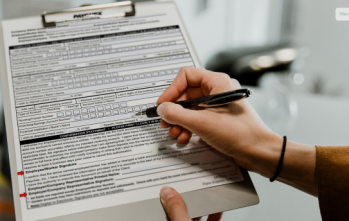Table Of Contents
- Points To Keep In Mind
- Importance Of Understanding The Parts Of A Check
- Essential Parts Of A Check
- Your Personal Information
- Check Number
- Date
- The Name Of The Recipient
- The Payable Amount
- Memo Line
- Bank Name
- Bank Routing Number
- Account Number
- Signature
- How Does Signature Work In Incase Of A Check Receival?
- Endorsement Line
- Padlock Icon
- To Wrap Up
- Points To Keep In Mind
- Importance Of Understanding The Parts Of A Check
- Essential Parts Of A Check
- Your Personal Information
- Check Number
- Date
- The Name Of The Recipient
- The Payable Amount
- Memo Line
- Bank Name
- Bank Routing Number
- Account Number
- Signature
- How Does Signature Work In Incase Of A Check Receival?
- Endorsement Line
- Padlock Icon
- To Wrap Up
Understating the Parts of a Check: What Each Component Means
Using a check can be a confusing process. Understanding the parts of a check when you are new to writing a check can be overwhelming.
Honestly, in this digital age, the use of a checkbook has been minimized. Digital payment methods have taken over quite easily. No one prefers using a checkbook. Especially not when they have their entire bank right inside the screen of their phone.
But using a checkbook has perks of its own. In many formal environments, checks are still the only way of payment. Therefore, you should always have the basic knowledge about a check and how it works.
The format mainly includes pre-printed information, which is vital to understand. There are blank spaces where you will have to fill in the name of the person or organization you are paying to, the total amount you are paying, your full signature, and so on.
Points To Keep In Mind
- A check comprises of either pre-printed or left blank information that you will have to fill in very carefully.
- If you understand the format of the check, it will help you set up direct depositing instructions, ensure that all the checks you have received are properly filled in, and order new checks.
- There are 12 mentionable parts of a check that mainly include your bank information, personal information, the amount you are paying, the name of the payee, and most importantly, your signature. A check without the payer’s signature is a complete waste.
Importance Of Understanding The Parts Of A Check
Although you must know the parts of a check to help yourself write a it, there are other reasons why understanding a check’s format is considered important.
Here are some of the reasons why it is important to understand the format of a check:
- To order new checks
- To make sure that the orders of the check come out correctly
- Setting up direct deposit instructions
- To double check if the checks that you have received are filled correctly
Essential Parts Of A Check
Although there is not much of a difference between the parts of a business check and the parts of a personal check, except one has a higher value limit than the other, here is a list of the parts of a check explained so that you can confidently use one the next time.
Your Personal Information

In the top left corner, you will see the name and the address of the account holder registered with the bank. If it is yours, it will be your name and registered residential address.
If you have moved or changed your address, you can still use the check as long as you have the same account number registered to it.
Check Number

It is situated in the check’s lower and upper right corners. The check number given on your checkbook is mainly used for tracking purposes.
For example, if your checkbook gets stolen, you can easily report which numbered checks were missing to the bank so they can easily track the duplicitous check withdrawals.
Date

The date section is in the check’s top right corner, just below the check number. You must be very careful of the date you put on the check.
Do not mistakenly put the same date on which the check got issued. You have to put the date on which the transaction should occur.
If you don’t want the recipient to withdraw the money before a certain date, you will most likely put that certain date on the check. This will not hamper your recipient’s ability to deposit the check earlier than the given date.
The Name Of The Recipient

The top line is situated in the middle of the check, where you will find it written “pay to the order of “is one of the most important parts of a check. This is where you put the recipient’s name, which can either be a person or an organization.
You must always try not to misspell the name of the recipient. Although that will not cause a lot of trouble, it is better to avoid such spelling mistakes all over.
You may also choose to pay to the order of “Cash.” By doing this, you give the allowance to anyone to cash the apps. You can do it in case of a situation where you are unaware of the name of the payee or unsure of how to spell it.
This might look like an easier option, but it doesn’t give you any control over who is cashing the check, So it is better suggested to write down the name of the specific recipient for safety purposes.
The Payable Amount

There are two sections that you will find in the check where you are required to give the payment details. The payments sections are the most important parts of a check.
The very first section is the empty box on the right-hand side, which is right beside the recipient’s name, where you will be putting the numerical value of the amount that you are paying [e.g., $10,770,50].
The second section is on the long line, which rests right below the recipient’s name. This is where you will be writing in words the amount that is payable to the payee [ e.g., Ten Thousand Seven Hundred Seventy and Fifty cents].
This helps the bank to get clarity on the total payable amount in case a word or a number is hard to decode.
Memo Line

Out of all the parts of a check mentioned here, this part is considered optional. Situated at the bottom left corner of the check, the Memo Line, although optional, is still recommended to be filled.
You just need to fill it up with the purpose for which you are writing the check, e.g., “April rent,” “tuition fees,” etc.
This will not only help your recipient to be aware of what the payment is for but will also help you remember the reason for the transaction when you later go through your finances.
Bank Name

In this section, you will find the logo of your bank and its logo, or the address, right above the memo line on the check.
Bank Routing Number

On the bottom left corner of the check, you will find a string of numbers known as the routing numbers. This is the identity of the bank that you are registered to.
It also indicates the regional location as well.
Account Number

The other set of numbers that you will find just beside the routing number on the check is your account number.
This is the account that is registered with the from which funds will get withdrawn or deposited in case a check is received.
Signature

It is located in the bottom right corner of the check. It is a blank line that you must sign.
Without the signature of the payer, the check will be of no value. When you sign the check, you officially give permission to the receiver to withdraw the fund from your account.
How Does Signature Work In Incase Of A Check Receival?

These are the extended parts of a check that you will not see on its front. They are the ones that you will need when you are on the receiving end of the check.
Endorsement Line
At times when you receive a check, flip it over.
What you will see is a blank line on the top of any of the short ends on the back of the check. That is known as the endorsement line.
While depositing the check, either through the ATM, through your mobile, or through a bank teller, make sure to sign on the blank line.
This shows that you are the intended recipient of the check and you authorize the deposit.
Padlock Icon
On the back of the check, you will find a small box including a padlock icon. You are not supposed to do anything about it.
The icon represents the security measures taken to prevent any fraud.
To Wrap Up
Although the use of checks has lowered over time, it is a given that one must at least be aware of the functions and parts of a check. As mentioned earlier, yes it is indeed overwhelming, but it is not rocket science.
The above-mentioned parts cover everything that you need to know about a check and how it works. Now it definitely would not be problematic for you to make a payment through the checkbook that you have owned for so long.
Explore More:











Leave A Comment